 |
| Category: Enemy/WW2 |

|
|
|
|
|
|
The Germans, unbowed by WW1
defeat came back for "The Second Show" |
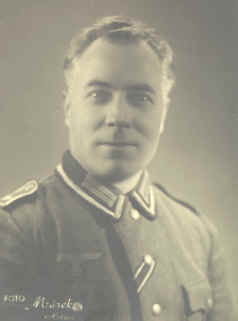 photo : Robyne Kirsch who adds
"My husband's grandfather who
was in the German army during WW2.
His name was Karl Kirsch, born
13th October 1904". He wears the ribbon of the Iron Cross (for bravery). |
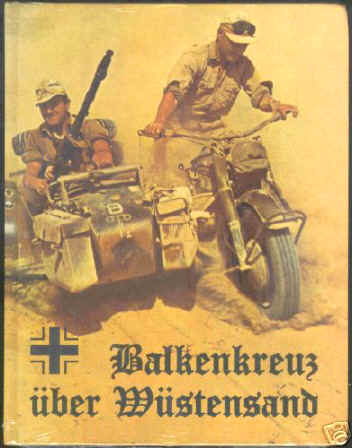
|
|
|
"Balkan Cross over
the Western desert." |
| Note. The artist's
impressions of uniforms on this page may well be the Copyright property
of Osprey
Publishing. Do not copy or use without approval from Osprey
Publishing. My permission is pending. |
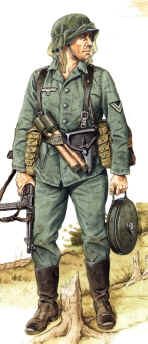 |
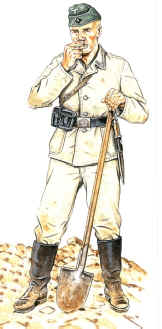 |
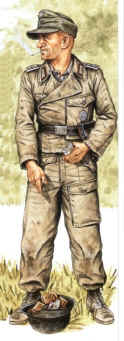 |
 |
| 1940
uniform |
1933
fatigue uniform |
Assault
artillery |
Tank
crew |
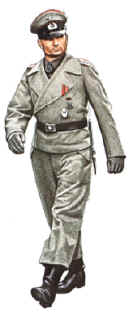 |
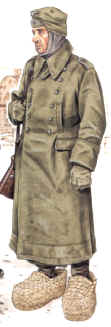 |
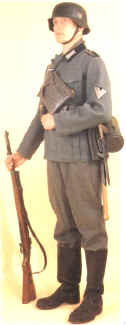 |
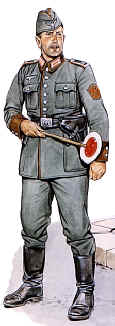 |
| Self-propelled
Artillery |
Winter
uniform |
Ordinary
soldier |
Military
Police |
|
21st Panzer of the Afrika Korps |
The
21st Panzer-Division was ordered formed by the Oberkommando des Heeres
from the 5.Leicht-Division on August 1st, 1941. The date of formation
listed by various sources is conflicting, and this seems due to the fact
that although the unit was ordered formed on August 1st, it most likely
did not come together until late in 1941. Many sources list the date of
formation as being in October, 1941. Panzer-Regiment 5, previously a
part of the 5.Leicht-Division already stationed in North Africa,
continued to function as a combat unit. When the change of formation
took place, the new 21st Panzer began to form while Panzer-Regiment 5
continued to operate in North Africa.
Most divisional histories list the 21st Panzer as seeing action first
during the British Operation Crusader, and although this is indeed the
first major action the unit saw, Panzer-Regiment 5, along with other
units now a part of the division, did see limited action much earlier.
On September 14th, 1941, units of the 21st Panzer-Division took part in
Operation Sommernachtstraum. This operation was to be a major
reconnaissance of the enemy lines across the border into Egypt, but did
not actually result in any significant engagement with the British.
When the British launched Operation Crusader, the 21st Panzer-Division
fought very well until depleted armour and a resolute 8th Army forced
Rommel to pull back his forces to positions around Gazala. After
continued British pressure, Rommel pulled back even more to positions
around El Agheila. All the while, the 21st Panzer-Division fought a number
of rear-guard actions against the advancing British. Thanks in part to
the actions of Panzer-Regiment 5 of the 21st Panzer-Division, the retreat
back to El Agheila was successful, although by this time the siege on
Tobruk had now been lifted and the British garrison was once again
reunited with the 8th Army. The relief would only be temporary.
In early January, 1942, after being resupplied and refitted, the DAK
went on the offensive against the British. In two weeks time, the DAK
had retaken Benghazi (January 29th) and had moved almost 350 miles. The
offensive slowed as the Germans reached the British position at Gazala.
All the while, the division took part in the advance. The British
position stretched from Gazala to Bir Hacheim in a ring of heavily mined
and fortified lines. The front settled here for the rest of Winter until
May, 1942, when Rommel once again launched an offensive against the
British. This offensive saw the division fighting in intense battles for
the Gazala line, eventually pushing the British from their positions,
finally taking Tobruk, and then moving all the way into Egypt, stopping
finally at Alma Half.
The 21st Panzer-Division next saw action in the Battles for El Alamein,
fighting in desperate battles against a vastly growing number of enemy
tanks. Against heavy loses and a growing number of British AFV's, the
Germans were pushed back from the El Alamein lines, and the division saw
action in rear guard operations that partially allowed the Germans to
retreat back across the border, across the Libyan Desert, all the way to
Tunisia.
When the 21st Panzer-Division arrived in Tunisia, it was put under the
control of 5.Panzerarmee, and then used as a number of Kampfgruppen in a
series of successive engagements against the Allies. From January 30th,
1943 to February 3rd, 1943, the 21st Panzer-Division was split into two
Kampfgruppen for action in the Faid-Maknassy engagements. Kampfgruppen
Grun was led by Werner Grun and was formed from Panzer-Abteilung
I/Panzer-Regiment 5, while Kampfgruppen Pfeiffer was led by Major
Pfeiffer, being formed from the Panzergrenadier-Battalion
II/Panzergrenadier-Regiment 104, Panzergrenadier-Battalion
III/Panzer-Grenadier-Regiment 104 and Tunis-Battalion 2. Kampfgruppe
Pfeiffer was then itself divided into "task forces" consisting
of Nord, Mitte and Sud.
Through-out the battles in North Africa, the 21st Panzer was used in
numerous Kampfgruppe formations like the one above, with Kampfgruppe
Pfeiffer taking part in many different actions being used again and
again.
Later in the defensive battles in Tunisia, Rommel himself took control
of the 21st Panzer while it fought in the battles for Kasserine Pass. The
Division was halted before being able to reach the actual pass itself.
Kampfgruppe Pfeiffer surrendered on May 11th, while the rest of the 21st Panzer
surrendered on May 13th when the Tunisian Bridge-head in North
Africa finally fell.
After being destroyed in North Africa, the 21st Panzer was reformed in
June of 1943 in France. It remained stationed in France for the next
year, being deemed unfit for service on the Eastern Front. The 21st Panzer
was still in France when the Allies launched their invasion of Normandy
in June of 1944, and the division was thrown into action against the
Allied positions as the only Panzer unit to do so on the 1st day of the
attack, June 6th. Most of its armour was lost early in the battles, but
the Grenadiers of the Division fought in and around Caen for many weeks.
When the Allies began the massive breakout of the Normandy beach area,
the division withdrew along with the rest of the German forces. The 21st Panzer
was then used in the Southern Sector of the Western Front
until it was pulled from the lines to refit and reform in Germany in
August, 1944. It was then rushed back to the Western Front to fight in
defensive actions during the general withdrawal through France, mainly
in the Saar and Alsace regions.
In Early 1945, the 21st Panzer was used in a drive on Strasbourg, and was
then shifted to the Eastern Front in February, 1945 where it fought in
defensive actions until being taken by the Soviets later in April, 1945. |
|